Probably most of the people are not interested in what I am about to write, so to save you some time:
LoCHAid stands for Low-income-countries-hearing-aid.
Why I have built has been inspired by an article referenced below and is based on cheap, ready made modules as in the article.
The disclaimer: every audiologist will tell you that a hearing aid is not merely a microphone with an amp and headphones.
Amplifiers amplify all frequencies, hearing aids amplify only what is required by a certain patient. Audiologist warn you against simple amps as they can be used too loud and cause more damage than good.
Audiologist are supposed to measure the patients hearing loss curve and set up the aid properly. This is what you are paying for. $$$ are not just for the actual device.
You have been warned.
I have two older member in the family who suffer from hearing loss (my father and my father in law).
My father in law lives in Very-high-income country and has state of the art hearing aid which he does not use very often. My father lives in a decent income country and refuses to buy a hearing aid.
The first impulse to do something for them came from the realization that my father in law listens to TV using headphones and the volume control in his TV is very cumbersome. So until recently he was listening to the sound at full volume.
I thought I can make him a small phone amp which will be used more like an attenuator. Not a hearing aid but in this case an attenuator should be beneficial. The result is here:
Then being a diyer I started looking for a diy hearing aid solution. I have found this article
https://journals.plos.org/plosone/article?id=10.1371/journal.pone.0238922
The idea is to use a small class d-amp (MAX98306) and a MAX9814 microphone module. The article contains links to a mother board pcb and a 3D printer enclosure. The authors use some high pass filters and show some results that this fits majority of the patients.
When I inspected the schematics I realised that the class d-amp used is in fact stereo so I thought I would make a stereo version. This cannot be done easily with MAX98306 because it is a "power amp" i.e. it is designed to be used with speakers and is (very) unhappy with the common ground connection in 3.5mm headphone jacks.
So instead I purchased MAX4410 which is a headphone amplifier. All the boards with MAX4410 I have seen use an on board 3.3V voltage regulator. I have decided to ditch it as I wanted to keep the whole device as small as possible - it was supposed to be powered of 2xAA batteries and all should fit in a a 4xAA battery holder.
The MAX 9814 modules can be programmed to 40,50 and 60dB gain. I ended up setting the lowest.
The device works fine. I suppose setting the volume to a level that one barely notices amplification should prevent extra hearing loss but should allow to have a decent conversation at a family table.
I will present teh device to my father next week and will inform how it was received.
PS My father in law is very happy with his headphone level attenuator.
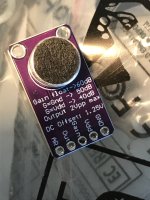
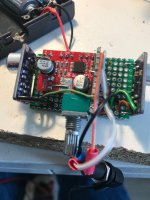
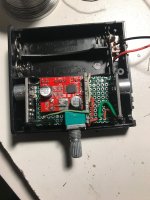
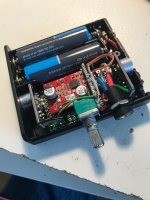
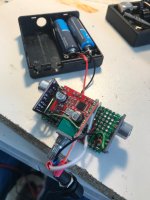
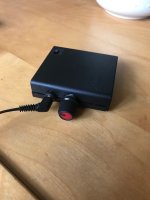
LoCHAid stands for Low-income-countries-hearing-aid.
Why I have built has been inspired by an article referenced below and is based on cheap, ready made modules as in the article.
The disclaimer: every audiologist will tell you that a hearing aid is not merely a microphone with an amp and headphones.
Amplifiers amplify all frequencies, hearing aids amplify only what is required by a certain patient. Audiologist warn you against simple amps as they can be used too loud and cause more damage than good.
Audiologist are supposed to measure the patients hearing loss curve and set up the aid properly. This is what you are paying for. $$$ are not just for the actual device.
You have been warned.
I have two older member in the family who suffer from hearing loss (my father and my father in law).
My father in law lives in Very-high-income country and has state of the art hearing aid which he does not use very often. My father lives in a decent income country and refuses to buy a hearing aid.
The first impulse to do something for them came from the realization that my father in law listens to TV using headphones and the volume control in his TV is very cumbersome. So until recently he was listening to the sound at full volume.
I thought I can make him a small phone amp which will be used more like an attenuator. Not a hearing aid but in this case an attenuator should be beneficial. The result is here:
This one I've made for my father in law (who has poor hearing and uses headphones to watch news on TV). It can be used with his IPad as well.
I wanted to keep it as small as possible. My first thought was a CMoy but then I realised that the world has moved on.
This is MAX4410 from Ali. It is not half bad in fact.
I wanted to keep it as small as possible. My first thought was a CMoy but then I realised that the world has moved on.
This is MAX4410 from Ali. It is not half bad in fact.
Then being a diyer I started looking for a diy hearing aid solution. I have found this article
https://journals.plos.org/plosone/article?id=10.1371/journal.pone.0238922
The idea is to use a small class d-amp (MAX98306) and a MAX9814 microphone module. The article contains links to a mother board pcb and a 3D printer enclosure. The authors use some high pass filters and show some results that this fits majority of the patients.
When I inspected the schematics I realised that the class d-amp used is in fact stereo so I thought I would make a stereo version. This cannot be done easily with MAX98306 because it is a "power amp" i.e. it is designed to be used with speakers and is (very) unhappy with the common ground connection in 3.5mm headphone jacks.
So instead I purchased MAX4410 which is a headphone amplifier. All the boards with MAX4410 I have seen use an on board 3.3V voltage regulator. I have decided to ditch it as I wanted to keep the whole device as small as possible - it was supposed to be powered of 2xAA batteries and all should fit in a a 4xAA battery holder.
The MAX 9814 modules can be programmed to 40,50 and 60dB gain. I ended up setting the lowest.
The device works fine. I suppose setting the volume to a level that one barely notices amplification should prevent extra hearing loss but should allow to have a decent conversation at a family table.
I will present teh device to my father next week and will inform how it was received.
PS My father in law is very happy with his headphone level attenuator.






I gave the device to my father.
I did not expect miracles but it is definitely making a huge difference!
My father is active in conversations again!!!
If I were to do it again (which I might) I am not sure I would use two microphones, I think one is enough. It opens a possibility to make the device smaller especially if powered with something like CR2032.
I did not expect miracles but it is definitely making a huge difference!
My father is active in conversations again!!!
If I were to do it again (which I might) I am not sure I would use two microphones, I think one is enough. It opens a possibility to make the device smaller especially if powered with something like CR2032.
On a related note, in America a few years ago they started allowing more economical hearing aids, which also let people like Apple include those features in their devices here. From ChatGPT: "In August 2022, the FDA finalized a rule that allowed over-the-counter (OTC) hearing aids to be sold directly to consumers without the need for a prescription or professional fitting. This new rule aimed to make hearing aids more accessible and affordable by removing some of the previous barriers.
Before this change, hearing aids were typically only available through audiologists or hearing aid professionals, often requiring an expensive consultation, fitting, and follow-up appointments. The high cost, which could run into thousands of dollars, was a significant barrier for many people with hearing loss."
Description of Apple features here:
https://www.apple.com/airpods-pro/hearing-health/
"The Hearing Test and Hearing Aid features are supported on AirPods Pro 2 with the latest firmware paired with a compatible iPhone or iPad with iOS 18 or iPadOS 18 and later" . . . . "The Hearing Aid feature is also supported on a compatible Mac with macOS Sequoia and later. It is intended for people with perceived mild to moderate hearing loss."
List of countries where they are available:
https://www.apple.com/airpods-pro/feature-availability/
Before this change, hearing aids were typically only available through audiologists or hearing aid professionals, often requiring an expensive consultation, fitting, and follow-up appointments. The high cost, which could run into thousands of dollars, was a significant barrier for many people with hearing loss."
Description of Apple features here:
https://www.apple.com/airpods-pro/hearing-health/
"The Hearing Test and Hearing Aid features are supported on AirPods Pro 2 with the latest firmware paired with a compatible iPhone or iPad with iOS 18 or iPadOS 18 and later" . . . . "The Hearing Aid feature is also supported on a compatible Mac with macOS Sequoia and later. It is intended for people with perceived mild to moderate hearing loss."
List of countries where they are available:
https://www.apple.com/airpods-pro/feature-availability/
Thanks mattstat! I know phones have this feature. I thought a simple box with a volume control might be easier for my father. The first step was to convince him that there is something that can be done about his condition.
We'll how it goes. He is using the amp on his own initiative. Which is good. We'll see how it goes.
We'll how it goes. He is using the amp on his own initiative. Which is good. We'll see how it goes.